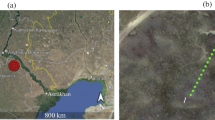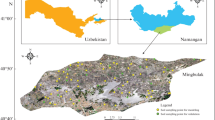Abstract
Soil salinity is a major environmental hazard. The global extent of primary and secondary salt affected soils is about 955 and 77 M ha, respectively. Soil salinity tends to increase in spite of considerable effort dedicated to land reclamation. This requires careful monitoring of the soil salinity status. The objectives of this study were: (a) to evaluate the capability of thematic mapper (TM) and multispectral scanner (MSS) imagery for mapping land cover types, (b) to analyse the spectral features of sail crusts relative to bare soil and gravely soil surface conditions, and (c) to detect the soil salinity changes during the period 1975–2004 in the Ardakan area located in the central Iranian Deserts. The Landsat MSS and TM on two different dates of September 14, 1975 and September 11, 2004, respectively, were used. Due to great confusion between some classes, the TM 6 was included in the band combination. The result of the image classification based on the combination of TM bands 3, 4, 5, and 6 showed of the classification results. For multi-temporal analysis, both TM and MSS images were classified with the same method but with a different number of training classes. The TM-classified image was regrouped to make it comparable with MSS regrouped classified image. The comparison between the classified images showed about 39% of the total area had changed in 29 years. The result of this study revealed the possibility of detecting important soil salinity changes by using Landsat satellite data





Similar content being viewed by others
References
Alavi Panah SK (1997) Study of soil salinity in the Ardakan area (Iran) based upon field observations, remote sensing and a GIS. P. 292. Gent: University of Gent (Ph. D. thesis).
Alavi Panah SK, Barzegar F, Ahmadi H, Komaki Ch B (2002) Study of Yardang Lut Desert based on Image Processing. Academic Research, University of Tehran pp.150.
Alavi Panah SK, Matinfar HR, Alikhah ASLM (2005) Optimization of urban mapping in satellite images by combining thermal and reflective remotely sensed date. Sixth International Conference on Asia GIS, Malaysia
AlFugara AM, Pradhan B, Mohamed TA (2009) Improvement of land-use classification using object-oriented and fuzzy logic approach. Applied Geomatics 1(4):111–120
Ben-Dor E (2001) Quantitative remote sensing of soil properties. Agronomy 75:174–234
Dwivedi RS, Sreenivas K (1998) Image transforms as a tool for the study of soil salinity and alkalinity dynamics. Int J Rem Sens 19(4):1907–1914
Goossens R, Van Ranst E (1996) The use of remote sensing and GIS to detect gypsiferous soils in the Ismailia Province (Egypt), Proceeding of the International Symposium on Soils with Gypsum. Lleida, Catalonia, Spain, pp 15–21
Jensen JR (1983) Biophysical remote sensing. Annals of association of American Geographer 1(73):111–132
Lillesand TM, Kiefer RW (2004) Remote sensing and image interpretation, 5th edn. Wiley, New York
Lu D, Mausel P, Bronizei E, Moran E (2004) Change detection technique. Int J Rem Sens 25(12):2365–2407
Mahmoud A, Shendi MM, Pradhan B, Attia F (2009) Utilization of remote sensing data and GIS tools for land use sustainability analysis: case study in El-Hammam area, Egypt. Central European Journal of Geosciences 1(3):347–367
Mas JF (1999) Monitoring land-cover changes: a comparison of change detection techniques. Int J Remote Sens 20(1):139–152
Masoud AA, Koike K (2006) Arid land salinization detected by remotely-sensed landcover changes: a case study in the Siwa region, NW Egypt. J Arid Env 66(1):151–167
Mather PM (1987) Computer processing of remote sensing images, an introduction. Wiley, New York
Metternicht GI, Zinck JA (2003) Remote sensing of soil salinity: potentials and constraints. Remote Sens Environ 82:1–20
Pradhan B, Saulaiman Z (2009) Landcover mapping and spectral analysis using multi-sensor satellite data: a case study in Tioman Island, Malaysia. J Geomatics 3(2):71–78
Shalaby A, Tateishi R (2007) Remote sensing and GIS for mapping and monitoring land cover and land-use changes in the Northwestern coastal zone of Egypt. Applied Geo 27(1):28–41
Townshend NA, Quarmby AC, Millington ND, Reading AJ, White KH (1989) Monitoring playa sediment transport system using thematic mapper data. Advances in Space Research 28:305–315
Yazd Soil and Water Institute (1983) Soil and salinity map and data. Yazd, Iran
Yeh AGO, Li X (1996) Urban growth management in the Peart river delta: an integrated remote sensing and GIS approach. ITC J 1:77–86
Author information
Authors and Affiliations
Corresponding author
Rights and permissions
About this article
Cite this article
Matinfar, H.R., Alavi Panah, S.K., Zand, F. et al. Detection of soil salinity changes and mapping land cover types based upon remotely sensed data. Arab J Geosci 6, 913–919 (2013). https://doi.org/10.1007/s12517-011-0384-6
Received:
Accepted:
Published:
Issue Date:
DOI: https://doi.org/10.1007/s12517-011-0384-6




